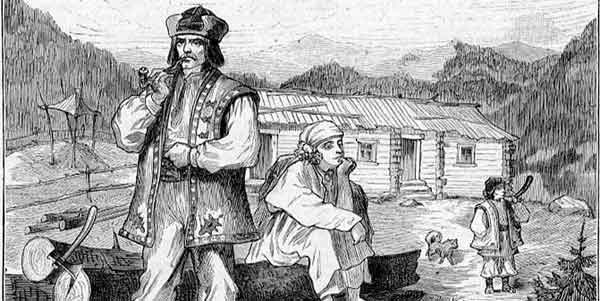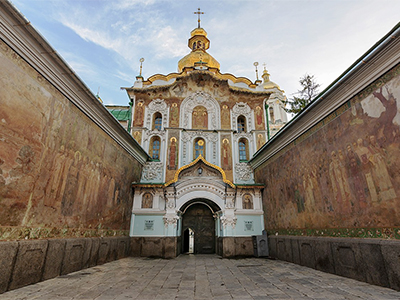 20.04.2018
Hutsul pipe
20.04.2018
Hutsul pipeA true Hutsul cannot be imagined without a pipe
“You are tobacco, and I am a pipe, let’s have a smoke there” or “Without hatchet and pipe Hutsul is not Hutsul” – say the Hutsul bywords. Since ancient times a hatchet and a pipe became for the Carpathian highlanders a friend, and brother, and adviser; a true Hutsul can not be imagined without these things. In conditions of the hardest social oppression only weapons, a flint and pipe saved opryshky.
Petro Shekeryk-Donykiv tells: “He put the hat on his head, got up from the ground, sat on the horse, lit his pipe, and went on a long way; he fell to thinking, and large tears rolled down like peas from his face”. Olga Kobylianska in her essay “Nature” describes Hutsul as follows: “Red trousers and a snow-white shirt with an embroidered collar and sleeves, from under which strong corded arms were notable. A chest, neck and hands were embellished with silver and brass chains and crosses, and a wide leather belt was decorated with thimbles and coins; behind it a pipe and some weapons were stuck.”
Old Hutsul woman smoking a pipe
Often women did not refrain from smoking a pipe and smoked out their fear, sadness or worry. Let’s remember Mariia Krechuniek (Chukutyha), who became familiar because of the photo made 1926 by Mykola Senkivsky “Old Hutsulka“, where the 90-year-old woman in Hutsul festive clothes was represented with a pipe. This photo took the Grand Prix at the international photo exhibition in Paris. Although only few people know that Chukutyha has been famous for her unique songs. Nowadays, in her native village a competition of Hutsul songs is hold in her honor. All who knows and loves the family mountain songs is invited there.
Mykhailo Kotsiubynsky wrote in his story “Shadows of Forgotten Ancestors”: “The child grew slowly, but still grew up; the time run quickly away and he needed the pants. But also he was strange. He looked ahead of himself, but saw some distant and unknown to anyone or cried without cause. His pants fell down, and he stood in the room, closed his eyes, opened his mouth and screamed. Then the mother took out the pipe from her teeth, lifted her hand against him and furiously shouted: – That’s enough for you! Flick out of sight!”
Faika – a ladies pipe
Looking at the collection of pipes in the Museum of Antiquities of Roman Kumlyk you can meet some delicate in appearance, so-called “lady faikas“. Smoking was not forbidden for Hutsul women, but young girls did not smoke. Married, obese mistresses sometimes considered that it looked arrogantly to stay on road with a stick and smoke a pipe.
The highlanders called a pipe “faika“?. Many stories and legends were composed, a great number of books and studies were published about “faika”? in Hutsulshchyna; it was attributed to be having magical properties. In the literature the image of devil smoking faika is known. There are many pictures of wise men having white moustache, it means the Gods, with the pipe in hand.
A pipe in a Hutsul culture
A pipe for Hutsul is a symbol of life experience, maturity. It was smoked in campaigns, passed by inheritance. Faika was not any consumers goods like today; it was considered a perfect article of art, and smoking a pipe had its certain tradition and ritual.
Hutsuls coped well with herbs, and mainly they did not smoked tobacco or some other abomination, but they smoked the mixture of the Carpathian herbs that were special – miraculous, healing, medicinal; through these herbs a gift of crying and foresight could be opened. Many tribes in the world used smoking herbs as a part of their shamanic practices and awoke to life the incurably sick person. In the Ukrainian history Hutsuls could only be compared with the Cossacks, who were famous for their passion for the pipe: “A wide steppe is my matchmaker, a saber and pipe are my family, and a gray horse is my brother.” Since the early 20th century pipes were replaced by cheap cigarettes.
Famous Hutsul pipe masters
Such masters become famous by making the Hutsul metal pipes: Lukin Dutchak (the late 18th –early 19th centuries) from the village Brusturova, Nykyfor Rebenchuk (1876-1949) from the village Yavoriv (was famous for the manufacture of the Hutsul pipes of brass plates which were skillfully decorated with engraving), Vasil Samokishchukfrom the village Sokolivka, Fedir Kharinchuk (1872-1940), Dmytro Kharinchuk, Ivan Myronuiuk (1880-1957) from the village Krasnoillya.
One of the most famous Hutsul engravers was Andriy Shkribliak. A Czech ethnographer František Rzhehorzh wrote about him that in his art he “was unmatched” among his contemporaries. And he added: “In his work we see the freedom and the wealth of imagination that characterize a true talent”. The Emperor in person grew fond of the talented master’s works so mach, that he ordered the master a pistol, knife and powder-flask, and also a belt, bag, and of course a pipe. For his work Shkribliak received from the Emperor 50 golden coins – almost half a ton of wheat could be bought for this money.
In our time there are only a few pipe masters in Hutsulshchyna. 72-year-old Hutsul from the Carpathian village Lazeshchyna Mykhailo Shmadiuk is perhaps “the last pipe master” as he is called in the Ukraine, and probably he is the only master in Transcarpathia who maintained the ancient mountain art. Almost half a century he makes Hutsul pipes and hatchets.
“How did I learn? My great-grandfather was a specialist in this work, and my uncle so was; I learned also from them. That was such a family … Nikora, who went with Dovbush, was my great-grandfather. He made hatchets and pistols for Opryshky”.
Mykhailo Shmadiuk is a smith and carver; he knows encrusting and casting well. Also he is a gunsmith and watchmaker, as he says – “time-master”. During his life he produced more than a hundred original products. His works adorn the souvenir market at the Yablunytsia pass. The aged Hutsul prides: “All museums in Ukraine have my works in their collections. And it is difficult to find a state where there is no my works – they are everywhere. They are in Germany, Hungary, Czech, Poland – everywhere. The orders were sent to me and I made different things”.
It’s not so easy to make a small hatchet, it’s necessary to spend at least two days, but with a pipe it’s even harder – a work is fine, almost jewelry, and every detail is important. “This metal alloy Hutsuls call “bakont”?. They can have a metal chibouk or a wooden one”, – says Shmadiuk.
The master longs for the past: “By this time almost nobody needs a pipe. There is a master in Kosiv, Roman Strynadiuk, do you know about him? … So he can do it. But there are no more in Ukraine such masters except him and me. And there were a lot of such pipe masters…” “The youth looks for a “clean” work, and not such “gypsy”, he says showing the sprained hands.
Hutsulschyna changes losing the native traditions bearers; once ago Hutsul could be recognized by his clothes which showed from what village he came. Today many people decide to come and stay in the village, but they develop the strange, modern culture, and not traditional one.
Nevertheless, like any Hutsul, Mykhailo is cheerful, upbeat and humorous, he prides of his favorite pipe and says that it is only for parade – long ago he has given up smoking. But he would prefer not to leave his difficult job: “Though I see badly, but I can not live without work, I itch to do something …?”
-
 27.02.2024
World of pysanka
Embark on a journey into the captivating world of Pysanka, the Ukrainian...
27.02.2024
World of pysanka
Embark on a journey into the captivating world of Pysanka, the Ukrainian...
-
 29.01.2024
Exploring the Treasures of Kyiv’s Lavra Monastery
In the heart of Kyiv lies the venerable Lavra Monastery, a testament...
29.01.2024
Exploring the Treasures of Kyiv’s Lavra Monastery
In the heart of Kyiv lies the venerable Lavra Monastery, a testament...
-
 13.01.2024
Kachanivka, Eden on Earth
Rich in history, it hosted renowned artists, notably poet Taras Shevchenko.
13.01.2024
Kachanivka, Eden on Earth
Rich in history, it hosted renowned artists, notably poet Taras Shevchenko.

